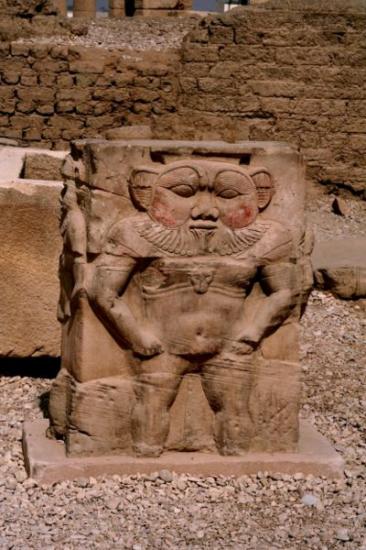Egyptian Deity Pendant, Herodian Structure Fragment Found in Jerusalem Dig
Source - http://popular-archaeology.com/issue/september-2012/article/pendant-herodian-structure-fragment-found-in-jerusalem-dig

The excavated ruins of a Byzantine wall in the Ophel, with a modern street behind. Photo courtesy Shmuel Browns of Israel Tour Guide.
While deep within excavations of an ancient Byzantine tower structure in the Ophel area of Jerusalem, a team of archaeologists, students and volunteers recently unearthed two important finds representing ancient times that were centuries apart.
The first, only about one inch in length, was a small white necklace pendant made from faience (see video below).Originally green, the pendant was a figurine depicting the ancient Egyptian god Bes, a deity worshipped as a fertility god and protector of families and households, and in particular, of mothers, children and childbirth. The find is rare in that it is the first and only artifact of its kind, that of Bes, ever found in Jerusalem. Other Bes finds have been found throughout Egypt (See example, below , capital of a column to god Bes at Dendera, Egypt. Steve F-E-Cameron, Wikimedia Commons).

The artifact was first encountered by Elizabeth Blondeau, a volunteer with the Herbert W. Armstrong College, excavating along with team mates in the now famous Ophel area archaeological excavations directed by Dr. Eilat Mazar of the Hebrew University. "I found it while I was digging in a corner of an installation," she said. "I was diging out the wall and it [the pendant] cascaded down with the dirt." According to Area Supervisor Amir Klonymous, the find may be related to a level associated with the Iron Age. The Iron Age in Jerusalem corresponded to a time when, according to the Biblical account, the kings of Israel and Judah reigned.
Dr. Mazar noted that figurines and pendants of Bes were "very common during the second millenium and also during the First Temple Period". The First Temple Period began with the construction of Solomon's Temple (otherwise known as the "First Temple"), during the 10th century B.C. She points to the widespread influence of the Phoenicians at Jerusalem during the Iron Age. "The Phoenicians loved these figurines. They used them alot."
The second find, a large architectural fragment dated to the Herodian period (37 B.C. to 70 A.D.), was also found within the excavations of the Byzantine Tower (see video below). The fragment is part of a richly decorated Roman corinthian style cornice, thought to have once belonged to a relatively small structure built presumably near the Temple Mount that existed during the first half of the 1st century A.D. Said Mazar, "The decorations are typical of this type, very commonly used during the Herodian period in Roman Herodian architecture, especially in Jerusalem......Most probably all these decorations are coming from the Temple Mount and fell down during the destruction of 70 C.E. (A.D.)"
The Ophel excavations are being conducted just south of the current Temple Mount area, which today contains the familiar al-Aqsa Mosque and Dome of the Rock. The excavations are focusing on the same area where recent excavations have uncovered not only finds dated to the Second Temple, Hellenistic, Roman, and Byzantine periods, but also what Mazar and others suggest may be the remains of structures attributed to builders during the period of King Solomon in the 10th century B.C. These remains included a section of a massive wall of large, well-dressed stones 70 meters long and 6 meters high. Also uncovered with the wall was a structure interpreted as an inner gatehouse, a royal structure adjacent to the gatehouse, and a section of a corner tower 8 meters long and 6 meters high, built of carved stones.
More information about the ongoing excavations in Jerusalem's Ophel can be obtained by going to the website, The Key to David's City.
.